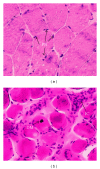Muscular dystrophies at different ages: metabolic and endocrine alterations
- PMID: 22701119
- PMCID: PMC3371686
- DOI: 10.1155/2012/485376
Muscular dystrophies at different ages: metabolic and endocrine alterations
Abstract
Common metabolic and endocrine alterations exist across a wide range of muscular dystrophies. Skeletal muscle plays an important role in glucose metabolism and is a major participant in different signaling pathways. Therefore, its damage may lead to different metabolic disruptions. Two of the most important metabolic alterations in muscular dystrophies may be insulin resistance and obesity. However, only insulin resistance has been demonstrated in myotonic dystrophy. In addition, endocrine disturbances such as hypogonadism, low levels of testosterone, and growth hormone have been reported. This eventually will result in consequences such as growth failure and delayed puberty in the case of childhood dystrophies. Other consequences may be reduced male fertility, reduced spermatogenesis, and oligospermia, both in childhood as well as in adult muscular dystrophies. These facts all suggest that there is a need for better comprehension of metabolic and endocrine implications for muscular dystrophies with the purpose of developing improved clinical treatments and/or improvements in the quality of life of patients with dystrophy. Therefore, the aim of this paper is to describe the current knowledge about of metabolic and endocrine alterations in diverse types of dystrophinopathies, which will be divided into two groups: childhood and adult dystrophies which have different age of onset.
Figures




Similar articles
-
Dysregulation of calcium homeostasis in muscular dystrophies.Expert Rev Mol Med. 2014 Oct 8;16:e16. doi: 10.1017/erm.2014.17. Expert Rev Mol Med. 2014. PMID: 25293420 Review.
-
Nondystrophinopathic muscular dystrophies including myotonic dystrophy.Semin Pediatr Neurol. 1996 Jun;3(2):110-21. doi: 10.1016/s1071-9091(96)80040-4. Semin Pediatr Neurol. 1996. PMID: 8795845 Review.
-
[Cardiac, respiratory and sleep disorders in patients with myotonic dystrophy].Przegl Lek. 2009;66(12):1065-8. Przegl Lek. 2009. PMID: 20514907 Review. Polish.
-
Hypogonadism is common in men with myopathies.J Clin Neuromuscul Dis. 2008 Jun;9(4):397-401. doi: 10.1097/CND.0b013e318176eb55. J Clin Neuromuscul Dis. 2008. PMID: 18525423
-
Circulating Biomarkers in Muscular Dystrophies: Disease and Therapy Monitoring.Mol Ther Methods Clin Dev. 2020 May 22;18:230-239. doi: 10.1016/j.omtm.2020.05.017. eCollection 2020 Sep 11. Mol Ther Methods Clin Dev. 2020. PMID: 32637452 Free PMC article. Review.
Cited by
-
Hormonal and metabolic gender differences in a cohort of myotonic dystrophy type 1 subjects: a retrospective, case-control study.J Endocrinol Invest. 2020 May;43(5):663-675. doi: 10.1007/s40618-019-01156-w. Epub 2019 Nov 30. J Endocrinol Invest. 2020. PMID: 31786795
-
Elevated GLUT4 and glycogenin protein abundance correspond to increased glycogen content in the soleus muscle of mdx mice with no benefit associated with taurine supplementation.Physiol Rep. 2018 Mar;6(5):e13596. doi: 10.14814/phy2.13596. Physiol Rep. 2018. PMID: 29484837 Free PMC article.
-
Hypogonadism Associated with Cyp19a1 (Aromatase) Posttranscriptional Upregulation in Celf1 Knockout Mice.Mol Cell Biol. 2015 Sep;35(18):3244-53. doi: 10.1128/MCB.00074-15. Epub 2015 Jul 13. Mol Cell Biol. 2015. PMID: 26169831 Free PMC article.
-
Multidisciplinary approach to the management of myopathies.Continuum (Minneap Minn). 2013 Dec;19(6 Muscle Disease):1650-73. doi: 10.1212/01.CON.0000440664.34051.4d. Continuum (Minneap Minn). 2013. PMID: 24305452 Free PMC article. Review.
-
Exploring lipin1 as a promising therapeutic target for the treatment of Duchenne muscular dystrophy.J Transl Med. 2024 Jul 16;22(1):664. doi: 10.1186/s12967-024-05494-z. J Transl Med. 2024. PMID: 39014470 Free PMC article.
References
-
- Dalkilic I, Kunkel LM. Muscular dystrophies: genes to pathogenesis. Current Opinion in Genetics and Development. 2003;13(3):231–238. - PubMed
-
- Rando TA. The dystrophin-glycoprotein complex, cellular signaling, and the regulation of cell survival in the muscular dystrophies. Muscle and Nerve. 2001;24(12):1575–1594. - PubMed
-
- Bushby K. Recent advances in paediatric muscular dystrophies. Current Paediatrics. 2004;14(3):214–222.
-
- Motlagh B, MacDonald JR, Tarnopolsky MA. Nutritional inadequacy in adults with muscular dystrophy. Muscle and Nerve. 2005;31(6):713–718. - PubMed
-
- Bianchi ML, Biggar D, Bushby K, Rogol AD, Rutter MM, Tseng B. Endocrine aspects of duchenne muscular dystrophy. Neuromuscular Disorders. 2011;21(4):298–303. - PubMed
LinkOut - more resources
Full Text Sources
Medical

